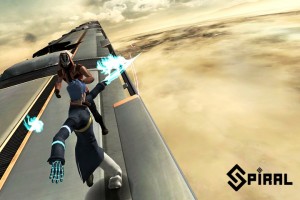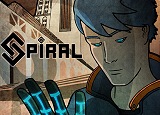 Pixel Hero announced Spiral March 5 if memory serves, but just how much pre-production and development work had gone into the project by that time? Have you found yourselves approaching the game development process much the same way as you did while working at big companies, or has the indie life given you an opportunity to throw the rule book out and organize your project in a drastically different way?
Pixel Hero announced Spiral March 5 if memory serves, but just how much pre-production and development work had gone into the project by that time? Have you found yourselves approaching the game development process much the same way as you did while working at big companies, or has the indie life given you an opportunity to throw the rule book out and organize your project in a drastically different way?
We started working on the project back in September 2011, knowing we were going to announce and demo the game at GDC a full six months down the road. The first few months were spent running tests with Unreal on a variety of different iOS devices to get a sense for how far we could push them, as well as doing a large number of extremely simple prototypes. We didn’t actually start on the GDC demo until January, which made for a hectic couple of months, as we were pulling together all the different prototypes into one, as well as trying to make something that looked presentable visually.
Our current development process is really just a refinement of what we’ve each experienced before, but tailored to the fact that we are a small, independent team. We still had pre-production and prototyping phases, and we still have milestones and deadlines we’ve set for ourselves. There is a definite plan for everything we are doing!
However, I think some of the advantages we’ve had compared to a big company are ease of communication, and the shared responsibility for the project each team member has. We don’t have to compose lots of emails or attend three different meetings with various levels of management to make a change. Being able to just turn around from our desks, face each other and chat about any ideas or concerns has allowed us to be more agile and efficient. We can constantly evaluate what we are doing and make changes when needed (time and budget permitting).
Everyone on the team has a say about the final product. We all talk about the art, design, marketing, etc. Personally, I love looking at how much the game has changed from what I had initially conceived. It’s definitely a project that belongs to the whole team, and I think that’s really important. Whilst it’s necessary to have an overall vision and aim, it can be very difficult to visualize and manage every component of a large game as an individual. What has really helped the project grow has been letting people on the team express their ideas, take ownership and push areas they feel passionate about all whilst having a clear goal. I think that’s inherently something that can be harder to maintain in a larger studio.
 It looks like story is going to play a big role in Spiral. What can you tell us about the main character, Tempus, and his world at this point – and what is the “Spiral” exactly? Would you say the story came first and the gameplay came together around that, or did the team start out with some cool gameplay features and the story evolved while you were fleshing those out?
It looks like story is going to play a big role in Spiral. What can you tell us about the main character, Tempus, and his world at this point – and what is the “Spiral” exactly? Would you say the story came first and the gameplay came together around that, or did the team start out with some cool gameplay features and the story evolved while you were fleshing those out?
Tempus is a private investigator based in a city called Soleil. Soleil is one of a few mega-cities that have formed after a great war that left much of the planet in ruins. The city itself has three layers, with the top two of these literally floating above the bottom one. Tempus lives on the middle layer of the city.
The level we demoed at GDC was a chunk of the first chapter, which introduces the player to Tempus on a mission where he has been hired to help police protect a mysterious package en route to Soleil. Obviously trouble ensues, and the package is stolen, which sets up part of the initial mystery and is the main story arc of the first episode.
Tempus also has a techno-organic right arm, with its own A.I. that can communicate directly with his brain, helping him solve cases…or not! As for the name “Spiral,” it represents different things in the game. There is a virus spreading through the population called the “Spiral” virus, named after the patterns it leaves on its victims. However, it also references some of the themes in the story as a whole, such as the concept of a world collapsing into chaos; a spiral of madness, lies and deceit.
From a development point of view we had some core concepts for the overall story, events, relationships and key plot points ready at a high level up front, but have otherwise tried to allow for the gameplay to take charge. We’re absolutely making a game and not a movie, so while there is a narrative focus, we’ve tried to make sure that the onus is on the game being fun, balancing the internal logic and rules of the world to some extent around the gameplay, all while hitting our key plot points. We’ve already moved things around a fair bit in the first episode, so I imagine we’ll keep tweaking in the future if there’s something we really want to do gameplay-wise.
 We haven’t seen much in the way of virtual buttons in screenshots yet – and I take it there’s good reason for that! What’s your approach to implementing a fully touch interface in a genre this complex? How does combat handle, versus exploration and puzzles?
We haven’t seen much in the way of virtual buttons in screenshots yet – and I take it there’s good reason for that! What’s your approach to implementing a fully touch interface in a genre this complex? How does combat handle, versus exploration and puzzles?
That is not a coincidence! One of our big aims is to totally remove the need for virtual buttons in the game. There are Post-its around the office with “One finger controls!” written on them everywhere. We’re really pushing a one-touch control system for the entire game: everything from exploration to puzzles and combat can be executed with a touch or swipe from one finger. It sounds really simple, but has been a real challenge to implement. There are so many interactions and mechanics required for each gameplay element that making player input feel consistent throughout is particularly tricky, and that’s why we spent a lot of time prototyping.
We took a good hard look at a lot of console games. Seeing what functions they offered, which ones we felt the player really needed, and thinking of ways to automate and streamline certain functions based on what we could do with a touch screen — with one finger. For example, most of the time the player is able to control the camera, looking around and rotating it around the character with simple swipes, whilst movement is either a tap on any location to walk, or a double tap to run. However, during combat we take control of the camera and allow the player to focus on the gameplay and use swipes to input actions like grabs and throws. It’s certainly been an interesting process for us to go through, and I’m sure we’ll continue to fine tune and adjust throughout development.
I remember when Aaron and I were initially talking about the project and we were discussing how great it would be to be THE game that managed to bridge that gap between consoles and mobiles, particularly as far as the control scheme was concerned. Touch screen devices aren’t going anywhere, and whether or not game controllers and other peripherals become available for them, in order for a wider range of games to succeed on these platforms the challenge of an intelligent and streamlined input system for these devices still needs to be solved, and sooner rather than later!


